Kabbalah comes from the Hebrew word kbl and this means to receive or accept, so it demonstrates that Kabbalah is about revelation or knowledge but it also needs tradition. It is rabbinical, conservative and regards text as fixed, its meaning always the same but to be found (through faithful interpretation). It combines revelation with the occult in terms of secret extractable knowledge by those who have the literate and numerical key. Some say the Torah was made by God before creation and Kabbalah's methods reveals the universe. For Kabbalists the Torah is the secret life of the Divine and truth is infinite. By one account at least (the Kabbalist Rabbi Isaac Luria, quoted in Berg, 2003, 60), the Universe came from nothingness called the Endless World of infinite light contracted into a single point of primordial space which took a ray of light from the Endless World that expanded rapidly in space. This is the creative divine and it produced the Four Worlds.
A core concept that gives rise to Kabbalah is in how the voice of God is heard. Some say the Torah was first heard by Adam himself, capable of understanding its deepest meanings, as were the prophets. According to the likes of Rabbi Mendel of Rymanov, the Chassidic Kabbalist, Moses had the mystical insight of the restricted sound of God that gave knowledge of the alphabet and communication, an understanding that ordinary people around him receiving the commandments did not have. This can include the Oral Torah. He was aware of the deepest meanings locked into the language. Others have trained to gain technique to find the deep meanings. So in a learned fashion Kabbalah extracts knowledge from the Hebrew Bible based principally on the numerical method called gematrion, along with other methods notarikon and temurah.
Kabbalah therefore involves numerology. Pythagoras said that all relationships can be represented by numbers. The Greeks pursued this idea, as did the Babylonians, the Egyptians and, in Kabbalah, the Jews, as well as others. Joining language (and the importance of sound) and number joins revelation and the occult.
Western occult deals with 9 numbers because of the Hindu-Arabic number system (the zero gets discarded when it appears) in first making letter to number associations (A to I is 1 to 9 and so is J to R, and S to Z reaches 8) and repeatedly adding together hundreds, tens and units until a single number is produced, being called the root number. These root numbers mean characteristics of people. It may offer insight or be little other than a party game, for example finding one's lucky number.
Jewish numerology connected revelation to the mystical power given to the Hebrew language, specifically the used twenty two consonants.
There are many numbers resulting from added up individual words, but different words can lead to the same number. This suggests correspondences of meanings.
There are seventy two Names of God, being rather seventy two sequences of three letters at a time (Berg, 2003, 195), shown below.
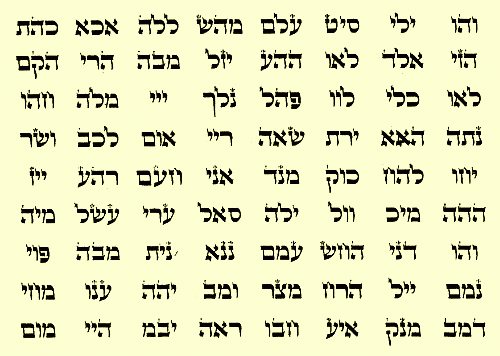
As well as the literate - numerological element there is the hierarchy of spiritual and material as represented by the Kabbalah mandala, itself expandable into Jacob's Ladder.
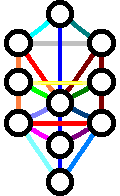 In Kabbalah's structure the spiritual stands above the material. First of all the Ayin or No thing and Ayin Sof or The Limitless (these meaning God) decided to create existence in order to reflect back its image. The space for existence was made by God withdrawing a portion of his volume for existence to have space. Light was projected into this existence, representing the Divine Will, producing four universes held together by the Divine Will. This is represented in Jacob's Ladder. From this action came the Tree of Life of ten sephirot, twenty-two connecting paths (the same number as the consonants), and sixteen triads. So God, known by the unspeakable sacred name YHVH, but substituted by Elohim and Jehovah, is the purely spiritual and unknowable creator who made himself more and more materially manifest through the stages of sephirot. The sephirothic Tree of Life mandala displays this range between the spiritual and material going down the tree. Going up the tree by means of contemplation and meditation involves gaining higher spiritual knowledge. The creation always works back up to the root (just as words relate to their root) and that root is the spiritual Divine. Going down there are the four worlds of the created cosmos in order of realisation:
In Kabbalah's structure the spiritual stands above the material. First of all the Ayin or No thing and Ayin Sof or The Limitless (these meaning God) decided to create existence in order to reflect back its image. The space for existence was made by God withdrawing a portion of his volume for existence to have space. Light was projected into this existence, representing the Divine Will, producing four universes held together by the Divine Will. This is represented in Jacob's Ladder. From this action came the Tree of Life of ten sephirot, twenty-two connecting paths (the same number as the consonants), and sixteen triads. So God, known by the unspeakable sacred name YHVH, but substituted by Elohim and Jehovah, is the purely spiritual and unknowable creator who made himself more and more materially manifest through the stages of sephirot. The sephirothic Tree of Life mandala displays this range between the spiritual and material going down the tree. Going up the tree by means of contemplation and meditation involves gaining higher spiritual knowledge. The creation always works back up to the root (just as words relate to their root) and that root is the spiritual Divine. Going down there are the four worlds of the created cosmos in order of realisation:
Sometimes an extra semi-sephirah of Daath or Knowledge is placed just below the junction between Binah and Chakhmah horizontally and Keter and Tiferet vertically. Otherwise knowledge can be how Binah is described.
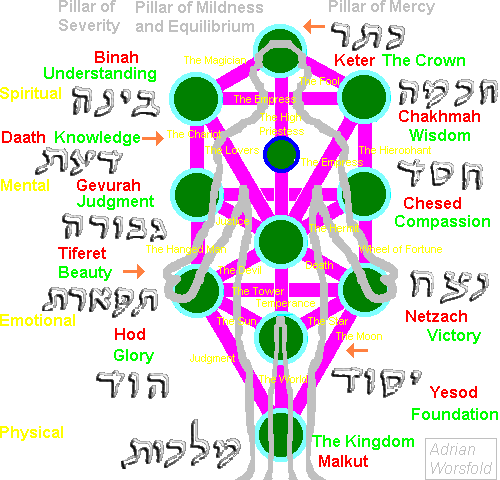
| In the diagram above yellow and grey text is additional to the tradition in Judaism. Red text is Hebrew transliteration (spelling is almost inevitably inconsistent) and green text is a translation. The smaller blue circle is semi-sephirotic only, the addition of knowledge. Small yellow text names twenty two Tarot cards. Orange arrows point labels to the central pillar. The body outline indicates that Kabbalah is represented in the human being, and gives a suggestion of chakras (including the Crown), the body representing the micro nature of the universe. |
 Here is a likely interpretation of the sephirot. Nine of the ten sephirot are so arranged in the Tree of Life that they are in triangles of two opposing and one neutral force. Malkut varies from this structure. Each sephirah controls its part of the cosmos. The first sephirah has the crown as the position of contact with the divine for unity, healing and peace. It is the Prime Mover. A lightning flash produces Binah, which is divine understanding (for example, of laws), and Chakhmah, which is revelation and a divine wisdom that can mean active and profound change. These three make up the Supernal Triad. The often missing Daath is a gnosis or direct knowledge without doubt: in a lesser sense it is facts. Gevurah can be harsh and relates to the will (fighting for) and focusses as judgment on coming to a view and truth-protecting energy. Chesed is fatherly love and is about passionate involvement and showing mercy. Teferet is as the sun, the centre, description of the whole, a life force into the personality and contributing to the sense of self as one. Hod is the mental realm: intuition, the shine of the essence, and information processing and communication all together. Neztach is nature and its forces, which can translate as fight or flight and other rapid instincts as well as more simply putting things into action. Yesod is as the moon, and concerns matters of depth, often about getting things right and before moving on; but as foundation it is also about primary needs like survival and personal security and the base of matter. Malkut is about the whole object, being grounded on the earth and in present time, the grounding being within the Divine. It can also be seen as almost pantheistic (but panentheistic), because its number ten means all things.
Here is a likely interpretation of the sephirot. Nine of the ten sephirot are so arranged in the Tree of Life that they are in triangles of two opposing and one neutral force. Malkut varies from this structure. Each sephirah controls its part of the cosmos. The first sephirah has the crown as the position of contact with the divine for unity, healing and peace. It is the Prime Mover. A lightning flash produces Binah, which is divine understanding (for example, of laws), and Chakhmah, which is revelation and a divine wisdom that can mean active and profound change. These three make up the Supernal Triad. The often missing Daath is a gnosis or direct knowledge without doubt: in a lesser sense it is facts. Gevurah can be harsh and relates to the will (fighting for) and focusses as judgment on coming to a view and truth-protecting energy. Chesed is fatherly love and is about passionate involvement and showing mercy. Teferet is as the sun, the centre, description of the whole, a life force into the personality and contributing to the sense of self as one. Hod is the mental realm: intuition, the shine of the essence, and information processing and communication all together. Neztach is nature and its forces, which can translate as fight or flight and other rapid instincts as well as more simply putting things into action. Yesod is as the moon, and concerns matters of depth, often about getting things right and before moving on; but as foundation it is also about primary needs like survival and personal security and the base of matter. Malkut is about the whole object, being grounded on the earth and in present time, the grounding being within the Divine. It can also be seen as almost pantheistic (but panentheistic), because its number ten means all things.
The question is, how might it work dynamically. This is called Lightning (it going through the whole Tree). It brings the Tree to crativity. Here I go to my own interpretation because some, for example that by Z'ev ben Shimon Halevi (1997, 33-34), do not seem to work given what the Tree is trying to do (and his are not the only example)
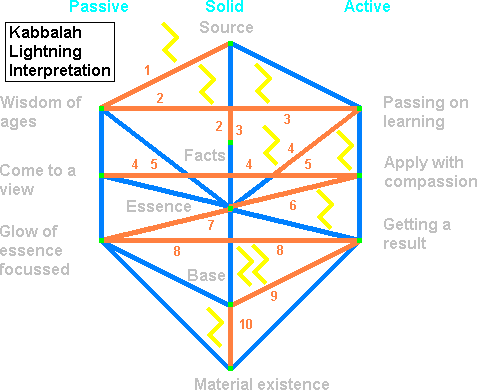
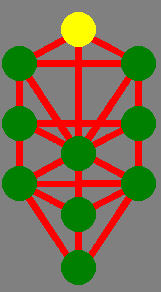 We can imagine painting a picture. There is the source or Crown, that of what art is at the highest philosophical point of the activity and where it merges into all other activities. It is not approached in ignorance, for there is Binah or wisdom as built up through the traditions (such as why the Golden Mean was used, some of the higher insights of the great masters, or matters of the colour wheel in the science of colour). This wisdom has to be passed on and applied, but not before collecting from Daat the totality of relevant knowledge. The process of application means coming to a judgment. In any painting this means decisions are made at Gevurah forming the approach. The process considering the painting involves considering application at Chesed with honesty and compassion and with full account of the audience and any one else involved (a sitter, for example). Then there is the painting conceived at Yesod, where the whole is held at united to its fundamental level ready to release. Finally the painting is executed at Malkut. This sequence can be adopted for all kinds of creative activities, and other sequences are suggested. The dynamic should continue down the Tree so that adjustments are always made: the higher elements are either unchanged (source) or very little accumulated (wisdom).
We can imagine painting a picture. There is the source or Crown, that of what art is at the highest philosophical point of the activity and where it merges into all other activities. It is not approached in ignorance, for there is Binah or wisdom as built up through the traditions (such as why the Golden Mean was used, some of the higher insights of the great masters, or matters of the colour wheel in the science of colour). This wisdom has to be passed on and applied, but not before collecting from Daat the totality of relevant knowledge. The process of application means coming to a judgment. In any painting this means decisions are made at Gevurah forming the approach. The process considering the painting involves considering application at Chesed with honesty and compassion and with full account of the audience and any one else involved (a sitter, for example). Then there is the painting conceived at Yesod, where the whole is held at united to its fundamental level ready to release. Finally the painting is executed at Malkut. This sequence can be adopted for all kinds of creative activities, and other sequences are suggested. The dynamic should continue down the Tree so that adjustments are always made: the higher elements are either unchanged (source) or very little accumulated (wisdom).
What facilitated Kabbalah was the sacredness of the Hebrew language that happened when it ceased to be the venacular in the Babylonian exile period. In 722 BCE Assyria conquered the northern kingdom of Israelites and took them into exile. In 586 BCE the Babylonians destroyed Jerusalem and the Temple and the Jews went to exile in Babylon. They were able to return when in 538 BCE Cyrus the Great, King of Persia, conquered Babylon, but this involved persuasion and religious revival as the Jews were doing quite well in Babylon (there was considerable learning in Babylon too). That revival raised the religious role and mystery of Hebrew whilst the people spoke Aramaic. Further contact with Greek and Egyptian cultures added further mystery and exotic ideas due to philosophical learnings. Yet it was many centuries before the Kabbalah appeared. It apparently developed first in southern France and in written form possibly in the 1100s and 1200s (there may be earlier origins but these are generally given as supernatural and magical explanations about prophets and apparent deep discoveries). The clearest starting point is that about 1290 a main book (collection) was written called Zohar - The Book of Light (or Radiance) - by Moses de Leon. Zohar was written as an invented tradition in a deliberately antiquated manner. It intersected with Islamic ideas and touched Christianity. However, Kabbalah really took off in use with the stresses of the expulsion of Jews from Spain (1492) and Portugal (1495) and therefore altogether it was of Sephardic, Mediterranean and Mediaeval culture. Moses Cordovero wrote Pardes Rimmonim (Garden of Pomegranites) in 1548 giving Kabbalah an even more thoroughgoing treatment. Rabbi Israel Baal Shem Tov simplified the understanding of Kabbalah in the 1700s.
For the Jews, the totality of the techniques was initially transmitted orally amongst groups of priests and later was reserved for married men of over forty (on the claim that it would send others mad). There was always the stress on limiting mystical insight to those well versed in the Talmud; the tradition has rejected those without prior deep learning. However, some rejected this condition: the Chassidic movement was in its origins not always learned in this manner.
Pagans use the Jewish structure and implications are drawn. The first vertical represents the Pillar of Severity, which is female (negative forces in Judaism), the second the Pillar of Mildness and Equilibrium (ambivalent forces in Judaism) and the third is the Pillar of Mercy, which is male (positive forces in Judaism). For Pagans this naturally leads to characteristics of the Divine Mother and the Divine Father as represented in the Goddess and God. Horizontal levels also have meanings, from the Spiritual at the second to top level, to the Mental, to the Emotional, and to the Physical. This follows on from the Jewish order of the Divine to the created. Pagans also have the Qabalistic cross.
War and peace are represented by Gevurah and Chesed respectively. This follows the left column being regarded as active and the right regarded as passive whereas the central column is the Divine Will projecting downwards (midway between active and passive).
Following the micro-universe idea, a human being in the diagram has certain chakra like implications on the basis of there being very many chakras (otherwise the regular chakras of Root, Hara, Solar Plexus, Heart, Throat, Brow and Crown do not always fit well). Weak chakras related to animal instincts are in the legs, like Malkut, which are of no impact to humans. The Yesod is about ordinary functioning so chakras come into play when above this level. Netzach and Hod are areas of temptation and turbulence. Tiferet is about having energy and will and going forward to successes, but it can go wrongly into greed rather than to the good. Gevurah is the difficulty of negative wishes so Chesed is needed for positive wishes as generated in meditation or art (again there is this negative and positive relationship). In the top triad Binah is higher knowledge and Chakhmah is the higher spiritual journey. Keter is the Crown (a good fit with the Crown chakra), the point of complete awareness and spiritual enlightenment if realised. Humankind has the purpose of being conscious of the created order: all of Kaballah should reside in human beings with our imaginative and reasoning powers.
Tarot attaches its cards to the twenty two pathways between the ten sephirot. Eliphas Levi (real name: Alphonse Louis Constant), who was an occultist, made the connection from Tarot to Kabbalah in two books in 1855 and 1856 although the Kabbalah never dealt with Tarot itself. Claims are made about Kabbalah realising Tarot - but not outside the Tarot community. There is no origin of the Tarot in the Kabbalah. Incidentally, invention in religion and magic is not a ground for rejection: arguably all of this Kabbalah is invention and it is just a question of time and expansion of ideas for the various imaginative developments. In the currently most popular pack called the Venetian or Piedmontese Tarot there are seventy eight cards, and twenty two of these are in the Major or Greater Arcana (Arcana translates as secrets or mysteries). These provide twenty two pathways to the Divine along the connections on the Tree of Life (in Tarot order starting at 0 and ending at XXI, mixing the number systems:
0. The Fool
The Isis Urania Temple of the Hermetic Order of the Golden Dawn (that became a major deposit of magick) was where Dr. W. W. Westcott, S. L. MacGregor Mathers and Dr. W. R. Woodman set up a hierarchy using ten grades or degrees in three orders reflecting the ten sephirot of the Tree of Life. Arthur Edward Waite and Alistair Crowley developed this connection. The Oxford Golden Dawn Occult Society (a revival body after many schisms; there is one in Florida using the registered name The Hermetic Order of the Golden Dawn) retains its interest in Crowley and Kabbalah amongst other magick based traditions.
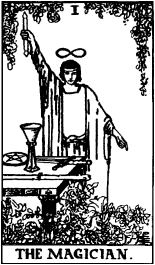
|
Then there is Astrology, where the impact of each sefirah is altered by time as the planetary systems alter by time. Indeed just as astrological charts vary day by day, so does the Tree of Life although for different collectivities and intentions the rate of change varies from moments to very long periods. Of course there are the Ages of 2000 years: Aries becoming Pisces (around the time of Christ) meaning the development of the monotheistic principle in near Eastern faiths, and now there is the dawning of the Age of Aquarius. This dynamic of varied change involves a process of creation and destruction, with principal opposites being Gevurah and Chesed (as elsewhere they represent war and peace). Other processes involve sephirot in death and renewal, one sepherah becoming another, or a sephira disappearing to reappear anew. Which becomes what seems to be open to the imagination and interpretation, and one can look at qualities that become higher, lower or other qualities. This means that Trees of Life have a history, and just as countless varieties have existed into the past so they will into the future. People who want to do something find, according to this view, their outcomes affected by the active effects of the sephirot they encounter according to what they seek.
It should be said about magick and magical religion that it is all based around Luck, and added meaning given to randomness and the denial of the random. It looks for detailed forces and causes which constrain. It arguably reduces freedom and ethical decision making, and, again arguably, one of the purposes of religion is to increase freedom (even by initial adherence: depending on how freedom is defined) and ethical decision making. Of course all religion is to some extent magical. Kabbalah in some contrast to magick is suggesting pathways to travel, to make ethical decisions, at least in terms of the Tree of Life if not in the numerology, which could be regarded as diversionary as a way to search meanings.
Then there is the Masonic tradition, its monotheism and Renaissance thought and how these work with Kabbalah. The limitless monotheistic God reflects himself in earthly experience by what comes down to human personal revelation. Masonic imagery can be connected by creative interpretation to Jacob's Ladder and the Kabbalah. God, of course, is the great architect, so there is knowledge fixed and mathematical in the creation to be found and passed on. This process needs journeying, and the parallel is with journeying through Jacob's Ladder and the Kabbalah. There is the journey within and its spiritual development: coming in (especially to a sacred Temple or chamber) and climbing stairs. The stairs also represent masonic authority as well as higher consciousness, the soul rising towards God. Journeying and movement also involves going east to receive knowledge and then west to give it to others as well as carry out charitable activities (including teaching). So going east and west, especially east, means rising up the Kabbalah and the Masonic system.
 Kabbalah has stretched across faiths and magick systems. Jewish Kabbalah has developed with incantations, seals, amulets and demonology to add to its letter and number mysteries. It has given some using interpretive knowledge the claim that they are messianic. Sabbatai Zevi (1626-76) was a self proclaimed mystical messiah but his successor Jacob Frank (1726-91) converted to Christianity. Another religious connection outward is the Donmeh movement that converted to Islam. There is a Roman Catholic version of Cabala based on Latin and the New Testament and adds the Old Testament and Hebrew. There is the Pagan Qabalah of magick drawing on Jewish insights and its alchemy, and there is a recent contemporary training version with the shallow attraction of American celebrities. For Islam, Arabic was declared so pure and complete in revelation that additional numerology was made redundant but of course there is calligraphic meaning and the sound of chanting the surahs. For Jews and Christians, there have been attempts at producing Bible code, as in random number regular letter positions using computers where predictions are made regarding world events.
Kabbalah has stretched across faiths and magick systems. Jewish Kabbalah has developed with incantations, seals, amulets and demonology to add to its letter and number mysteries. It has given some using interpretive knowledge the claim that they are messianic. Sabbatai Zevi (1626-76) was a self proclaimed mystical messiah but his successor Jacob Frank (1726-91) converted to Christianity. Another religious connection outward is the Donmeh movement that converted to Islam. There is a Roman Catholic version of Cabala based on Latin and the New Testament and adds the Old Testament and Hebrew. There is the Pagan Qabalah of magick drawing on Jewish insights and its alchemy, and there is a recent contemporary training version with the shallow attraction of American celebrities. For Islam, Arabic was declared so pure and complete in revelation that additional numerology was made redundant but of course there is calligraphic meaning and the sound of chanting the surahs. For Jews and Christians, there have been attempts at producing Bible code, as in random number regular letter positions using computers where predictions are made regarding world events.
 Kabbalah is its own tradition of pursuing meanings of the Jewish faith, deepening its concepts of revelation, the divine light, the divine sound, the holiness and organic nature of language that has numerical depth, and the divine root of the created universe. It is such an attractive and developed concept for those who seek an extra-universe reality that it has been developed by others in a process of colourful invention of traditions.
Kabbalah is its own tradition of pursuing meanings of the Jewish faith, deepening its concepts of revelation, the divine light, the divine sound, the holiness and organic nature of language that has numerical depth, and the divine root of the created universe. It is such an attractive and developed concept for those who seek an extra-universe reality that it has been developed by others in a process of colourful invention of traditions.
Berg, Y. (2003), The Power of Kabbalah, London: Hodder and Stoughton.
Halevi, Z'ev ben Shimon (1997), Tree of Life: An Introduction to the Kabbalah, Bath: Gateway Books.
Geddes and Grosset (1999), Dictionary of the Occult, New Lanark: Geddes and Grosset, 125-127, 162-165, 218-220, 226.
Geddes and Grosset (1999), Fate and Fortune, New Lanark: Geddes and Grosset, 89-188.
Adrian Worsfold